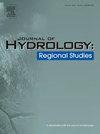Quantifying the impact of nuisance flooding on urban coastal communities under present and future climatic conditions: Norfolk, Virginia as a case study
IF 5
2区 地球科学
Q1 WATER RESOURCES
引用次数: 0
Abstract
Study region
Norfolk, Virginia, United States
Study focus
Nuisance flooding, characterized by frequent but minor floods, has been on the rise and the trend is expected to continue due to climate change. Utilizing a two-dimensional surface flow / one-dimensional pipe hydrodynamic model, this study presents a methodology for simulating flooding from low return period tidal and rainfall events to quantify the impact of nuisance flooding on urban coastal communities under present and future climatic conditions. Applying the methodology, the results show the impact of nuisance flooding from tidal alone and compound (i.e., rainfall and tide) events.
New hydrologic insights for the region
Using 2020 as a base year, the model suggests tidal nuisance flooding (TNF) impacts approximately 4 % (1.87 km2) of the study area. With a projected 1-meter sea-level rise by 2100, the TNF extent is projected to increase to approximately 12 % (5.85 km2) — more than tripling the 2020 TNF extent. For the 2020 base year, when rainfall and high tide occur simultaneously, compound nuisance flooding (CNF) leads to 11 % (5.15 km2) of the study area being inundated. By 2100, the projected inundated area by CNF is estimated to be 20 % (9.41 km2). Overall, sea level rise drives the expansion of TNF along riverbanks and adjacent areas, while submerging many urban drainage system outlets. This prevents efficient rainfall drainage, which causes CNF on inland low-lying areas.
量化在当前和未来气候条件下对城市沿海社区的有害洪水的影响:弗吉尼亚州诺福克作为案例研究
研究区域:美国维吉尼亚州诺福克研究中心恼人的洪水,其特征是频繁但小规模的洪水,一直在上升,并且由于气候变化,预计这一趋势将继续下去。利用二维表面流/一维管道水动力模型,本研究提出了一种模拟低回归期潮汐和降雨事件洪水的方法,以量化在当前和未来气候条件下城市沿海社区的滋扰洪水的影响。应用该方法,结果显示了潮汐单独和复合(即降雨和潮汐)事件对滋扰性洪水的影响。以2020年为基准年,该模型表明潮汐骚扰洪水(TNF)影响了大约4 %(1.87 km2)的研究区域。预计到2100年海平面将上升1米,预计TNF范围将增加到约12% %(5.85 平方公里),是2020年TNF范围的三倍多。在2020基准年,当降雨和涨潮同时发生时,复合公害洪水(CNF)导致11 %(5.15 km2)的研究区被淹没。到2100年,CNF预计的淹没面积估计为20% %(9.41 平方公里)。总体而言,海平面上升推动肿瘤坏死因子沿着河岸和邻近地区扩张,同时淹没了许多城市排水系统出口。这阻碍了雨水的有效排放,从而导致内陆低洼地区的CNF。
本文章由计算机程序翻译,如有差异,请以英文原文为准。
求助全文
约1分钟内获得全文
求助全文
来源期刊

Journal of Hydrology-Regional Studies
Earth and Planetary Sciences-Earth and Planetary Sciences (miscellaneous)
CiteScore
6.70
自引率
8.50%
发文量
284
审稿时长
60 days
期刊介绍:
Journal of Hydrology: Regional Studies publishes original research papers enhancing the science of hydrology and aiming at region-specific problems, past and future conditions, analysis, review and solutions. The journal particularly welcomes research papers that deliver new insights into region-specific hydrological processes and responses to changing conditions, as well as contributions that incorporate interdisciplinarity and translational science.
 求助内容:
求助内容: 应助结果提醒方式:
应助结果提醒方式:


